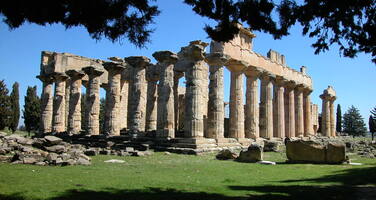Archaeological Site of Cyrene
Factors affecting the property in 2012*
- Crop production
- Deliberate destruction of heritage
- Housing
- Interpretative and visitation facilities
- Livestock farming / grazing of domesticated animals
- Management activities
- Management systems/ management plan
- Surface water pollution
Factors* affecting the property identified in previous reports
a) Need to complete the Management Plan in order to co-ordinate actions in the short- and medium-term;
b) Need to provide a detailed map at the appropriate scale showing the boundaries of the property and buffer zone;
c) Threat to rock-hewn monumental tombs as a result of inadequate protection, leading to vandalism and the development of agricultural activities in the rural zone and urban constructions;
d) Inappropriate earlier restoration work;
e) Problem of discharge of sewage from the modern town into the Wadi Bel Ghadir;
f) Inadequate on-site security and control systems;
g) Need for a presentation and interpretation system for visitors and the local population.
International Assistance: requests for the property until 2012
Total amount approved : 0 USD
Missions to the property until 2012**
January 2007: Joint World Heritage Centre/ICOMOS reactive monitoring mission; August 2008: World Heritage Centre mission.
Conservation issues presented to the World Heritage Committee in 2012
At its 31st session (Christchurch, 2007), the World Heritage Committee requested the State Party to complete and finish the management plan begun in 2006, to provide a map indicating the exact boundaries of the property and its buffer zone, and to inform the Committee of any new project, in particular those concerning the creation of a new urban development adjacent to the city of Shahat.
It also requested the State Party to strengthen staff at the Department of Antiquities responsible for the property, to avoid all violent and corrosive cleaning treatment, as well as excessive restoration work of the monuments that would adversely impact the authenticity and integrity of the property.
At the time of preparation of the present document, no report had been transmitted by the State Party, nor any new information has been received.
The World Heritage Centre has no knowledge on the current state of conservation of the property or progress in the appplication of successive recommendations of the World Heritage Committee. The only information available is that presented by the experts who participated in the international expert meeting convened by UNESCO on 21 October 2011 (https://whc.unesco.org/en/events/777), by the Blue Shield mission that visited the property in November 2011 and by international archaeological missions. According to these informations, it would appear that the recent conflict has not caused any damage to the property.
In this context, UNESCO has drafted two project documents to enable emergency safeguarding measures for Libyan cultural heritage to be undertaken. Funding for these projects is being negotiated.
Analysis and Conclusion by World Heritage Centre and the Advisory Bodies in 2012
The World Heritage Centre and the Advisory Bodies wish to underline the impact of the absence of documentation and management measures on security, control and protection of the property. Whilst understanding the difficulties caused by the recent conflict and the current situation in the country, they emphasize the need for a better knowledge of the precise boundaries of the property, the need to take into acount the threats linked to agricultural activities and uncontrolled urban spread, and an improved knowledge of the value of the property for visitors and the local population. Attention to the above would enable improved effectiveness in the conservation and management of the property.
Summary of the interventions
Decisions adopted by the Committee in 2012
36 COM 7B.54
Archaeological Site of Cyrene (Libya) (C 190)
The World Heritage Committee,
1. Having examined Document WHC-12/36.COM/7B.Add,
2. Recalling Decision 35 COM 7B.53, adopted at its 35th session (UNESCO, 2011),
3. Regrets that the State Party has not submitted a state of conservation report to its previous four sessions;
4. Urges the State Party to implement its earlier decisions and measures recommended by the joint World Heritage Centre/ICOMOS mission of January 2007;
5. Requests the State Party to submit to the World Heritage Centre, by 1 February 2013, a state of conservation report on the property and the implementation of its Decision 31 COM 7B.63 for examination by the World Heritage Committee at its 37th session in 2013.
Draft Decision: 36 COM 7B.54
The World Heritage Committee,
1. Having examined Document WHC-12/36.COM/7B.Add,
2. Recalling Decision 35 COM 7B.53, adopted at its 35th session (UNESCO, 2011),
3. Regrets that the State Party has not submitted a state of conservation report to its previous four sessions;
4. Urges the State Party to implement its earlier decisions and measures recommended by the joint World Heritage Centre/ICOMOS mission of January 2007;
5. Requests the State Party to submit to the World Heritage Centre, by 1 February 2013, a state of conservation report on the property and the implementation of its Decision 31 COM 7B.63 for examination by the World Heritage Committee at its 37th session in 2013.

Exports
* :
The threats indicated are listed in alphabetical order; their order does not constitute a classification according to the importance of their impact on the property.
Furthermore, they are presented irrespective of the type of threat faced by the property, i.e. with specific and proven imminent danger (“ascertained danger”) or with threats which could have deleterious effects on the property’s Outstanding Universal Value (“potential danger”).
** : All mission reports are not always available electronically.

